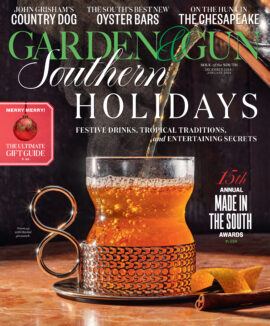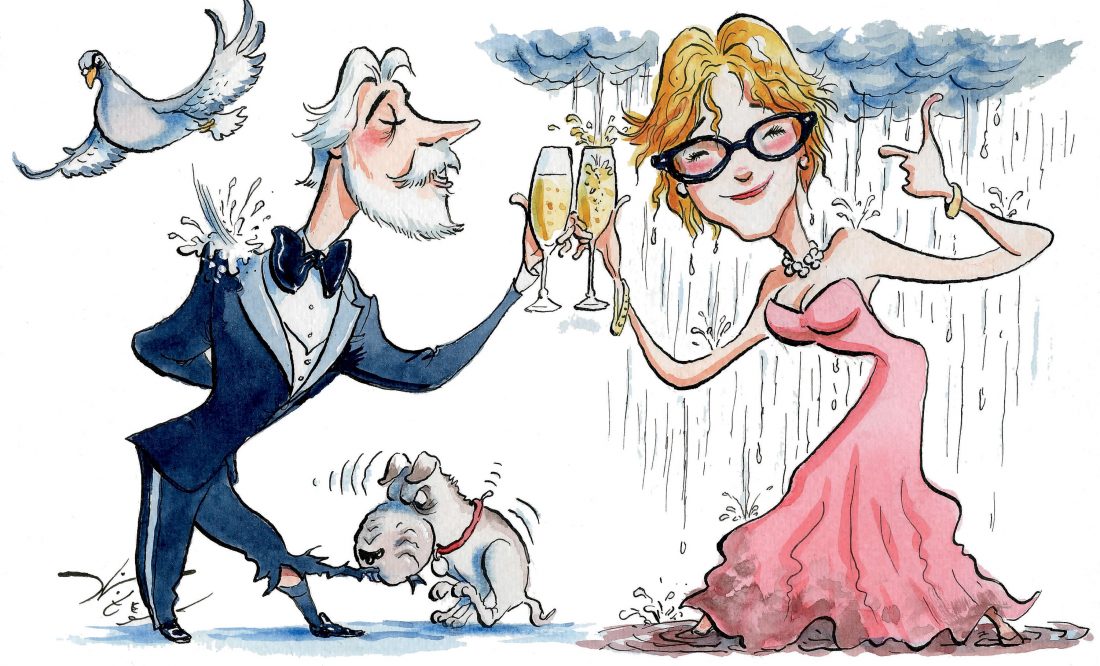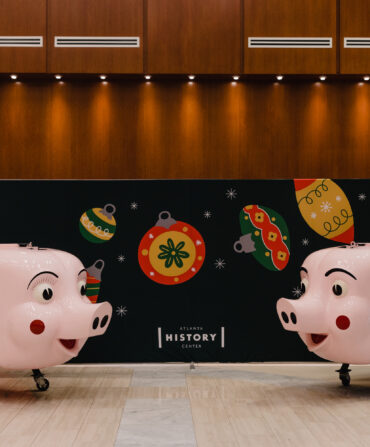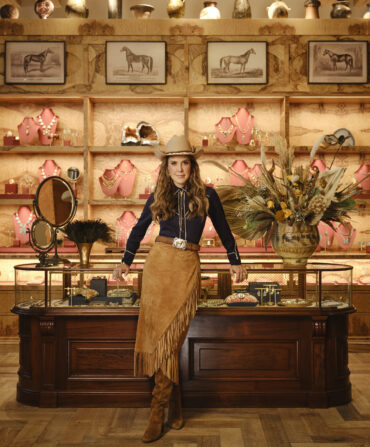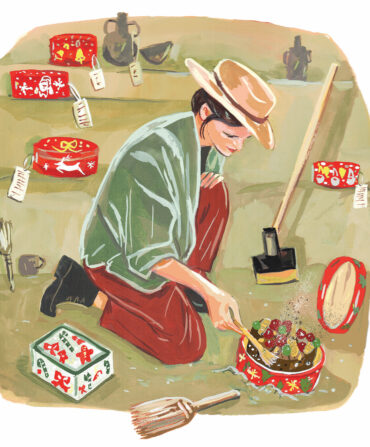“Function in disaster, finish in style” is one of the mottoes of the Madeira School, the all-girls boarding school in McLean, Virginia, where I happily spent my junior and senior years. Festina lente (“Make haste slowly”) is the official motto, the one engraved on our class rings, but as anyone who knows me can tell you, that’s not really my thing. I prefer the informal one, the one that was drummed into the student body by Lucy Madeira Wing, who founded the school in 1906, ten years after she graduated from Vassar. When my mother was at Madeira in the 1950s, Miss Madeira was still alive and pretty much kicking and she delivered the line to the assembled girls almost every morning.
I have been thinking about Miss Madeira and her guiding principle a lot lately. Perhaps because so few in our midst seem to be living by it. On a particularly bad day this summer, for example, I was driving from the Hartford, Connecticut, airport to the Vermont graduation of my good friend Ellen’s son, late and speeding (in defiance of the charge of the ring on my little finger), and listening to an especially incessant drumbeat of doom on NPR. My friend and favorite senator from Mississippi, a total class act and by far the best advocate for our poor state, was under siege from a primary challenger whom I’ll refrain from characterizing here in a Herculean effort to be a class act myself. War was escalating in so many places at once I was reminded of my Madeira Modern European History class and the lectures of the good Dr. Brown on the events leading up to World War I. A particular wing of the Republican Party seemed not to have taken even an elementary school civics class, much less modern history of any kind, and the administration was, well, being the administration.
The center does not hold, I thought. Common sense does not prevail. No one is functioning in disaster, much less finishing with a modicum of style. But then I made it to the graduation at the Burr Burton Academy atop a gorgeous green hill. The young women and men were all dressed up beneath their caps and gowns—my friend’s son, the handsome Eli, wore a fetching pale orange button-down shirt, a green tie, and a conservative but well-cut poplin suit. The leadership award was won by two beautiful girls who were best friends. The valedictorian talked about responsibility, integrity, service, and grit (grit!). And the speaker, a case study in Miss Madeira’s mantra, was Kevin Pearce, the snowboarder who suffered a traumatic brain injury and had to learn not just how to walk and talk again, but also how to swallow and brush his teeth. Now, he runs the Kevin Pearce Fund to help people with injuries like his. He told the kids he was “living proof you can overcome what you’ve been dealt,” that they should “focus on this moment and be proud.”
So we all did and we all were. We went to dinner at the nearby Downtown Grocery, owned by my fellow Mississippian Abby Coker and her husband, the brilliant chef Rogan. We had delicious rhubarb margaritas, bought a round of Miller ponies for the kitchen staff (per Abby’s menu instructions if we liked what we ate—and we loved it), lit sparklers at the table, and generally had a huge warm time.
Pretty much everybody that day had finished in style, and it made me realize once again that the best center to hold is your own. Which brings me back to Miss Madeira. Her simple definition of education was “discipline of the mind,” and I can tell you that in my two years at her school I worked and thought harder than I ever have since. She agreed with Robert Louis Stevenson’s opinion that the world had best hurry up and return to the “word duty and be done with the word reward.” She decreed that there would be no class rankings and grades would not be posted. She taught the public affairs and Bible courses herself (in my day, the latter had morphed into Ethics, but a good friend who took that small and intense class ended up with a PhD in theology and ministered to folks at a church near Ground Zero on 9/11).
My mother remembers that Miss Madeira was wild about the young queen Elizabeth and implored the girls to emulate not just her “dignity and quiet poise” but her proper low-heeled English shoes. “She hated the Capezio flats we all wore,” my mother says, adding that she thought them “sloppy.” Miss Madeira, described by Time in 1946 as “one of Washington’s last New Dealers,” told the magazine that she regretted the fact that most of her students came from “economic royalist” families and put them all in the same outfits lest they try to outspend each other. In spring, my mother reports, the girls dressed in green jumpers with white cotton blouses, while in winter it was the same blouse with a gray skirt and a yellow or green sweater. For dinner they changed into white piqué dresses, and in the senior portraits of my mother’s yearbook, every single girl has on a string of pearls.
I arrived well after the era of white piqué, in time to enjoy the hangover of the far more lax rules of the sixties, which would come to an abrupt end almost as soon as I left the gates. We had no adult supervision in our dorms and elected our own dorm mothers from our peers. We smoked pot in the woods and cigarettes on the outdoor smoking terrace or in the unspeakably grungy senior clubhouse. I kept a fifth of Scotch in my underwear drawer, and one of my dorm mates was in possession of a blender with which we made the occasional birthday daiquiri. The queen, who is now among my own heroines, was not much on our radar screens.
The equitable Miss Madeira would have been appalled at the charge accounts we had with the local taxi service, which we sent on runs for Häagen-Dazs and Chinese takeout (accompanied by six-packs of Tsingtao beer). A great many of us got around the lone dress code requirement of a skirt at dinner by wrapping our plaid gym kilts around whatever we were already wearing, which in my case was usually a pair of Levi’s pulled over the Lanz nightgown in which I woke up—the only outfit that would enable me to make it to chapel (barely) on time.
Looking back, the best I can hope for is that Miss Madeira would have perhaps been gratified that it was still impossible to tell anything about the wealth and class of most of us by our appearance—we all looked equally awful. (In our defense, some of the staff didn’t look a whole lot better—the school nurse was fond of combing mayonnaise through her steel-gray hair.) The only exceptions were the Carolina girls who wore wraparound skirts and the same cotton shirts of my mother’s era with gold clip-on earrings, add-a-bead necklaces, and Pappagallo flats or Weejuns. I met my own roommate, from Wadesboro, North Carolina, for the first time wearing my favorite Adidas T-shirt, ancient Levi’s, and a pair of earth shoes. She walked in with neatly coiffed hair and mascara, trailed by her brother, who was carrying, I swear, a crate of African violets for our windowsills. I ended up loving her, and, I think, she me, but I never saw the point of wasting time trying to pull myself together—except, of course, on Wednesdays.
Wednesdays were the days when we were bused into town for internships. In our junior year we all worked on Capitol Hill; in our senior year, we were supposed to know what we wanted to be when we grew up, so I worked at the Washington bureau of Newsweek, then owned by Katharine Graham, a Madeira alum who totally got the hang of our founder’s dictum. On those days, the style we most emulated was that of a thirty-five-year-old—the better to enable us to order martinis during our lunch breaks. So dramatically different was my own appearance that when I ran into my photography teacher in Lafayette Square in New Orleans, he had no idea who I was.
Let me pause and say here that I am not necessarily proud of some aspects of my school career. And I should hasten to reassure prospective Madeira parents that I would have lasted about an hour and a half under the current school rules. It’s a miracle I lasted then—when I attended a school function a year after graduation, the dean of students, Jean Gisriel (known universally as Miss Giz), stuck her formidable face about two inches in front of mine and said, with a mixture of profound disgust and surprisingly raw frustration, “I never could get you. I never could.”
Still, Miss Giz and the rest of our leaders (with the notable exception of Jean Harris, the murderous headmistress who arrived my senior year) managed to instill Miss Madeira’s core beliefs into us all. And the school itself is a prime example of holding it together in the direst of circumstances. After Mrs. Harris was arrested for shooting her ex-lover the Scarsdale Diet doctor, Herman Tarnower, almost every newspaper in the country identified her as the headmistress of the “posh” Madeira School. My mother was appalled, and fears were rife that applications would all but cease. But my father, as usual, got it on the money: “Every redneck in America is going to want to send their kid to that ‘posh’ place.” Sure enough, applications surged.
The school is still all girls and still thriving, and I am forever grateful for my time there and what it taught me. Not least of which is how to hold on tight and fake it during those trying stretches when functioning—and finishing—are not necessarily assured. To that end, I will repeat the line from my own senior yearbook page, not from Miss Madeira, but from Andrew Jackson: “You are uneasy; you’ve never sailed with me before, I see.”

